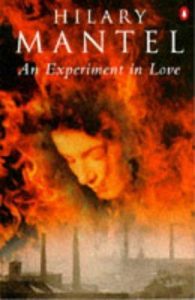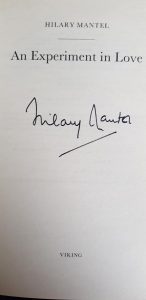Like nearly everyone else I read Wolf Hall, Bring Up the Bodies and The Mirror and the Light initially with excitement and latterly with keen anticipation. What an achievement! That DBE was richly deserved.
But of course Mantel had been a respected author for decades before she hit the high spot and became a household name. Reading her obituaries last month reminded me of this and inspired me to go in search of some of her pre-Wolf Hall work.
I found her 1995 An Experiment in Love on the shelves in my sitting room, a bit dusty and crying out to be reread. To my surprise it is a signed copy. Years ago I used to rub shoulders with Mantel at Royal Society of Literature meetings so perhaps I bought it in one of those occasions. I’m afraid I don’t remember.
Three very different young women arrive at a London student hostel in the late 1960s when the pill has just landed and abortion is legal in a limited way. Sex is very much on the agenda. They have all attended the same schools in the same northern town. It’s a retrospective first person novel whose narrator, Carmel – a diligent law student – is thinking back to the 1960s and while there she remembers growing up in the 1950s.

Karina, is the daughter of immigrant parents, presumably Eastern European Jews but Carmel is not sure. She doesn’t bother to make herself likeable and is an enigmatic character given to grotesque overeating. Julia, the medical student, with whom Carmel room-shares is more flamboyantly straightforward. As she drives the narrative forward, Carmel who has difficult parents and little money becomes dangerously anorexic, especially after she is ditched by her boy-friend from home.
There’s a pretty compelling plot which culminates in a dramatic, unexpected (to me anyway because I’d forgotten the details) climax. But what struck me most forcibly about this novel is the sheer, glittering brilliance of Mantel’s writing and its attention to detail: “Among the monochrome of their overcoats and mackintoshes you would see the fuschia or bluebird-coloured flash of a sari or shalwar-kameez” or “stacks of stiff shirts bound in Cellophane, from which they lifted jerseys with their arms strait-jacketed by cardboard in every size from dwarf to gross.” It’s so vivid it’s almost photographic and pulled me up short again and again as I read this novel.
Carmel – as Mantel did – passes the 11 plus and progresses to an old fashioned convent grammar school. Referring to one of the 11 plus papers she comments that “Intelligence was about picking the odd one out: beetroot, asparagus, cabbage pea. Hen, cow, jaguar, pig; pilot, fireman, engineer, nurse.” I remember that so well. We used to have whole books of these tests to practise with at home.
Another of the many things she evokes for me is grammar school uniform and going to buy it. “The shoe was brown, its toe was round, it had a bar across like an infant’s shoe. It had a sort of shelf running around it, a running board; its sole looked an inch thick” Yes! Although she doesn’t say so these least fashionable items of footwear were called “Clarks Indoor Shoes”. They were indeed hideous but, with hindsight. comfortable and practical and I suppose they helped to protect our growing toes from the sort of distortion we would have liked to force on them. I love the totally accurate “running board” comparison.
So it’s a coming of age novel and some of this detail, must – absolutely must – be rooted in Mantel’s own experience. Read or reread it for the sense of period and the unusual, unpredictable characters which people the narrative.

Next week on Susan’s Bookshelves: The Smallest Man by Frances Quinn